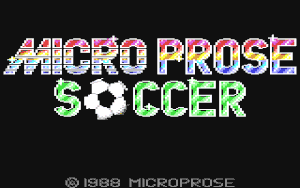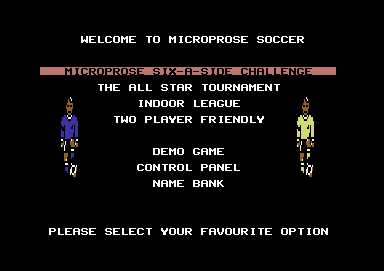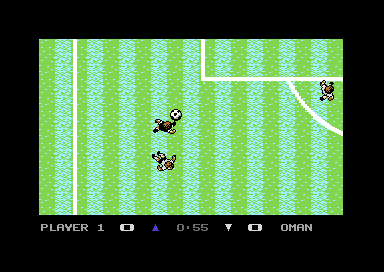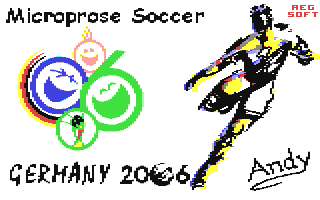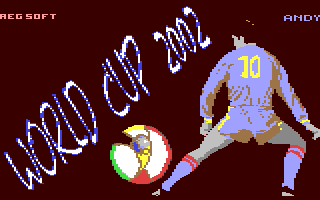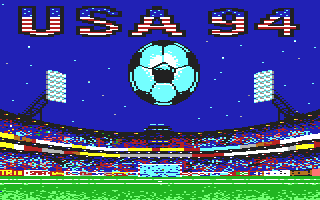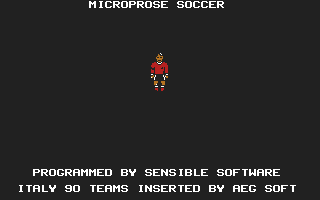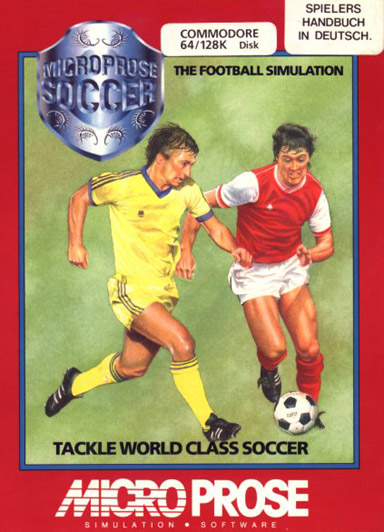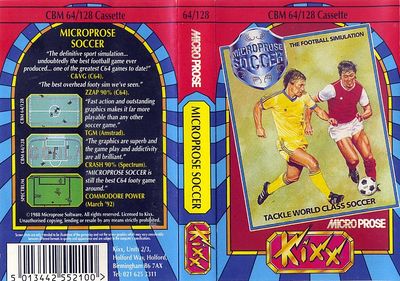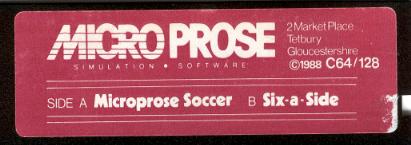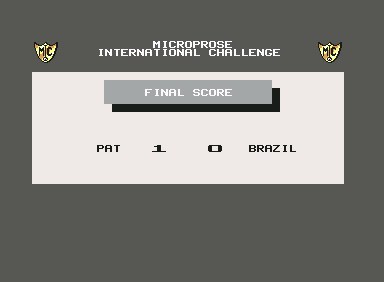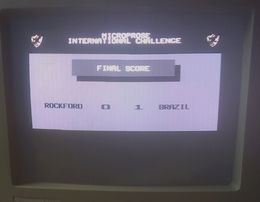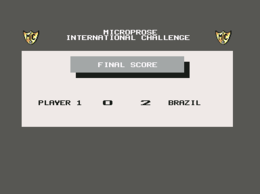Microprose Soccer
| Microprose Soccer | ||
|---|---|---|
| Game No. | 189 | |
| Voting | 8.42 points, 67 votes | |
| Developer | Chris Yates | |
| Publisher | MicroProse Software, Sensible Software, AEG Soft (inofficial) | |
| Musician | Martin Galway | |
| HVSC-File | /Galway_Martin /Microprose_Soccer_indoor.sid | |
| Release | 1988 | |
| Platform | C64, ZX Spectrum, Amiga, Atari ST, PC | |
| Genre | Sports, Football/Soccer (Arcade) | |
| Gamemode | Single player 2 players (in turns) 2 players (simultaneous) | |
| Operation | ||
| Media | ||
| Language | ||
| Information | Game On 06/1995 also released under the name "Keith van Eron's Pro Soccer" in the USA | |
Description[edit | edit source]
This soccer simulation was programmed by "Sensible Software" (known through "Wizball" and "SEUCK") and published by "Microprose" (which until then had made a name for themselves with mostly warlike simulations). The game consists of two different soccer simulations, you can carry out a match in the stadium or indoors. The field is always shown from the top and scrolled softly into all directions. The player that is controlled at the moment can be recognized by a flickering football shirt. If you have the ball you can pass or shoot. The longer you keep the fire button pressed, the sharper the shot will be. Additionally, the trajectory bends if the joystick is pressed to the left or right. If the opponent has the ball, you can try to take it away from him with a sliding tackle. When the own keeper gets visible, you take over his controls and a press on the fire button makes the keeper jump.
Indoor soccer has some fundemental changes to the rules. The ball cannot roll into the out, but it bounces from the cushion. Furthermore, the keeper can be the goalgetter himself (in contrast to the stadium where he is limited to the penalty area).
If a goal is scored, the scene is repeated in slow motion and one can watch the attack unhurriedly. Extensive and clearly arranged menus enable you to change many parameters of "Microprose Soccer". These range from the length of a match (2 to 12 minutes) to details of the controls. Also the weather can be changed and by this you can get a proper rain shower during the game by coincidence. With a wet ground the ball rolls further and the players sometimes slip.
Different game modes make for diversity. Up to 15 players can enter their names and then compete with each other in a league. One can also take part in a World Cup, whereby the venue corresponds to the one of a real World Cup. The computer takes over the controls of as many teams as needed. The strengths of the teams correspond approximately to the real national teams (random exceptions can happen). Scores can be saved any time and additionally there is a "Name Bank", a database with names of clubs, but there is limited memory, 16 clubs can be created. Therefore you cannot import the whole Premier League, but it is enough for an own league.
Design[edit | edit source]
The music fits well. The graphis are very realistic for the breadbox, (except for when you tacle or when there is a thunderstorm. Then there will be a nice display error, just try it). The gameplay is also very good. The players are controlled well and the keeper shows very good reaction. There are even banana shots! You can control them with the joystick after the ball has left the foot! There is thunderstorm, rain (you even see how the raindrops fall on the ground!!!), lightning and much more! During the replay there is even a rewind animation shown. The only thing that is not there is the terrace chants *SHALALALA*. Well, you have to imagine them...
Hints[edit | edit source]
- Controls in the menu
The game is controlled with the help of menus and a bar to choose the desired option. The bar can be moved with the joystick in one of the ports. When it is positioned on the desired option, press the fire button. The same menus are used with the Association Football and the soccer according to American rules with six players per team. The difference of the two types are the rules of the game.
- Main menu
When the game is loaded the following main menu appears, which alternates with the display of the lead text.
- Microprose International Challenge
- World Cup Tournament
- Soccer League
- Two Player Friendly
- Demo Game
- Control Panel
- Name Bank
- Quick start
Solo players should choose "Microprose International Challenge" in the main menu and press the fire button again, to go over the table of the challengers. After that choose PLAY BALL and press the fire button twice, to let the match begin. You will now play as player I against the team of Oman in the first challenge round.
If two players play, you should choose TWO PLAYER FRIENDLY in the main menu, then PLAY BALL and then press the fire button. The one who presses the fire button first to start the game will be player I the other player II. By this the game can start without further ado. However, it is recommended to read the section about the controls of the game as soon as possible to acquaint yourself with the subtleties of the joystick commands.
- Options menu
In the Control Panel you can adjust the many functions of Microprose Soccer according to your own taste. After pressing the fire button the sub menu appears:
- Selection Mode - Man/Auto
- Weather - On/Off
- Banana Power - Hi/Med/Lo
- Match Length - 2/4/6/8/10/12 Minutes
- Replays - On/Off
- Colour Mode - Col/B-W
- In Game Music - On/Off
- Save - Disk
- Load - Disk
Every option can be called up over the bar. By pressing the joystick several times you make your choice within an option.
- Controlling the players
The players at Microprose Soccer have a large room to manoeuvre. The movements can be done with the joystick and by pressing the fire button. If the fire button is not pressed, you can let your man run around on the field by using the eight directions of the joystick. The controls have three different "controls modes", depending on whether:
a) the ball is free in the game,
b) your player has the ball,
c) or your opponent has the ball.
- a) Make the player run over the field with the normal joystick movements to get the ball. When getting contact with the ball, your player automatically gets the possession of the ball, until he loses it again. If you press the fire button at the same time when you have contact with the ball, it is shot into the direction into which the player looks.
- b) In this mode, your player runs and dribbles the ball automatically. He only shoots if you press the fire button.
There are several different types of shots, depending on the position the joystick is in and how long the fire button is pressed. If you press only shortly, the shot will be correspondingly short, if you press it longer, the shot goes further.
When pressing the fire button the controls of the player by joystick is suspended; instead, you control the shot as you want to have it. To perform a shot, you press the fire button and instantly move the joystick in the desired direction:
- joystick forward: volley shot in a straight line
- joystick diagonal left/right: banana shot to the left or right
- joystick in neutral position: lifting shot
- joystick backward: overhead kick
NOTE: The direction of the shot is decided by the direction into which the player moved right before pressing the fire button. If your player e.g. ran into the southwestern direction and shall do a banana shot from left to right, you press the fire button an pull the joystick straight backward.
- b) In this mode, your player runs and dribbles the ball automatically. He only shoots if you press the fire button.
- c) If the opposing team can make it to get the ball, you have to try to regain the ball. When your player is close enough to the opponent and you press the fire button, he will try a sliding tackle. But this is only the case when you player moves and not when he is standing still.
If your player gets ball contact, the ball will get free in the game and can be seized. If the attack is unsuccessful, the opponent will simply still have the ball.
NOTE: If you try a sliding tacle on a wet field, this can have unexpected consequences!
If an opposing player gets close to your goal, the computer will ring and show that you now control the keeper with the joystick. In this case other rules for the controls apply. Pressing the fire button will effect a dive of the keeper in the following possibilites:
- Joystick to the right: keeper dives to the right
- Joystick to the left: keeper dives to the left
- Joystick in the middle: keeper jumps up
The keeper is also granted - same as in the real game - a kind of priority concerning the possession of the ball: With every contact with the ball, he automatically gets the owner.
- c) If the opposing team can make it to get the ball, you have to try to regain the ball. When your player is close enough to the opponent and you press the fire button, he will try a sliding tackle. But this is only the case when you player moves and not when he is standing still.
Additional keys
- "F1" - swap joysticks. If you press this key, you can swap the teams. This is useful, if a player has accidentally taken the wrong team at the start of the match or after the half time.
- "Run/Stop" - make a pause
- "Run/Stop" and "Q" - leave game
Complete manual
Solution[edit | edit source]
- The strong computer teams in the European version:
- Level 1: Oman, New Zealand, Japan
- Level 2: Cameroon, Canada, Australia
- Level 3: USA, Algeria, Northern Ireland
- Level 4: Chile, Wales, Ireland
- Level 5: Austria, Scotland, Hungary
- Level 6: Sweden, Mexico
- Level 7: Denmark, Poland
- Level 8: England, Spain
- Level 9: Uruguay
- Level 10: France
- Level 11: Soviet Union
- Level 12: Netherlands
- Level 13: Federal Republic of Germany
- Level 14: Argentinia
- Level 15: Italy
- Level 16: Brazil
Cheats[edit | edit source]
- As a "cheat" you can use a blunder in the AI. Walk into the penalty area and get the keeper to follow the player. This has the nice effect, that the opposing players on the field do not move any more. If you then stop shortly in front of the penalty area, the keeper stays on the other side of the line as if it was an insurmountable wall. Now you have a lot of time as nobody moves (this way you can also let the clock count down without hectic). Then you walk with the ball a few steps into the middle and circle the ball around the keeper into the net. This always works with a bit of practice.
- Also no "cheat" in the real sense: I always helped myself with the corner trick against the big nations (Brazil, Italy, Argentinia, Germany, Netherlands and Russia), and it works like this: Walk with a player to the opposing half between the penalty area and the corner flag, and stop shortly before the line. The following opponent then "slides" into the out, so you get a corner kick. A player is (automatically) placed at the corner of the penalty area, another one makes the corner kick, the opposing keeper dives off target, the player in the corner of the penalty area takes the ball and directly shoots diagonally - also here: Practice a bit, then it will always work! - by Snake Slobodan
Voting[edit | edit source]
| Voting of the C64-Wiki users (10=the best vote): | ||
| 8.42 points at 67 votes (rank 38). You need to be logged in to cast a vote. | ||
| C64Games | 10 | 22nd May 2006 - "highlight" - 9220 downs |
| Lemon64 | 8,56 | 6th October 2006 - 107 votes |
| Kultboy.com | 8,46 | 11th May 2007 - 13 votes |
| Gamebase64 | 10 | "Classic!" |
| ASM | 8/12 | Issue 1/89 |
| Powerplay | 90% | Issue 11/88 |
| ZZap64 | 90% | Issue 89/02 |
Reviews[edit | edit source]
Örg: "I think the game is in any case worth a look. If you have friends, you'd best make a tournament. This is most fun".
Guybrush: "The opening of every C64-party in my cellar, there are usually up to 8 players playing this game! Even today still suitable for parties. 9 out of 10 points"
lk-rj: "There is also a version of Microprose Soccer for the World Cup 2006 with the original World Cup 2006 logo."
Shakermaker303: "THE soccer game for the C64. The graphics and gimmicks are very successful (at that time a great idea: shoot the ball hard into the direction of the camera). The options menu is designed well and one can make nice changes, e.g. set to rainy weather. I like most the tournament mode with the fight for the Cup."
Snake Slobodan: "Concerning the graphics it is really a great game and some good ideas. I also like the tournament mode best, an own World Cup has something to it. Also the first mode, in which you play yourself up level for level, is okay - only the "private championship" would have been expandable. Nevertheless: a maximum of 10 points."
Miscellaneous[edit | edit source]
Trivia[edit | edit source]
The "Six-A-Side" indoor version on the second side of the disk is not just simply some indoor soccer, but it is - with the competing teams and the round boards - inofficially oriented on the actually existing Major Indoor Soccer League (MISL) (from 1978 to 1992), which was later called Major Soccer League (MSL) and should not bemixed up with the Major League Soccer (MLS) from today. This league had also licensed an "offical game" on the C64 ("MISL - Major Indoor Soccer League" by Mindscape, Gamebase64.com - Game No. 04561 ).
Award[edit | edit source]
- The game was awarded the British Golden Joystick Award in the category Best Simulation Game of the Year in 1989.
Inofficial versions[edit | edit source]
The game is available in inoffical versions by the Italian group AEG Soft:
- Gamebase64.com - Game No. 22104 Microprose Soccer - South Africa 2010
- Gamebase64.com - Game No. 19209 Microprose Soccer - Germany 2006
- Gamebase64.com - Game No. 14892 Microprose Soccer - Korea-Japan 2002
- Gamebase64.com - Game No. 4805 Microprose Soccer - USA 94
- Gamebase64.com - Game No. 4804 Microprose Soccer - Italy 90
In these hacked versions the teams of each World Cup are contained and have an adapted intro screen.
Cover[edit | edit source]
Disk label[edit | edit source]
Highscore[edit | edit source]
- PAT - Level 16 (1:0) (03.06.2015)
- Rockford - Level 16 (0:1) (03.05.2015)
- Equinoxe - Level 16 (0:2) (09.10.2011)
- Werner - Level 12 (08.10.2011)
- Helmutx - Level 11 (14.02.2010)
Links[edit | edit source]
- C64Games.de - Game No. 614
- Lemon64 - Game No. 1671
- Gamebase64.com - Game No. 4802
- C64.com - Game No. 581
- Test Report No. 850 on Kultboy.com

- ZZap64 test report
Videos
- Video at YouTube (Stadium)
- Video at YouTube (Indoor soccer)
